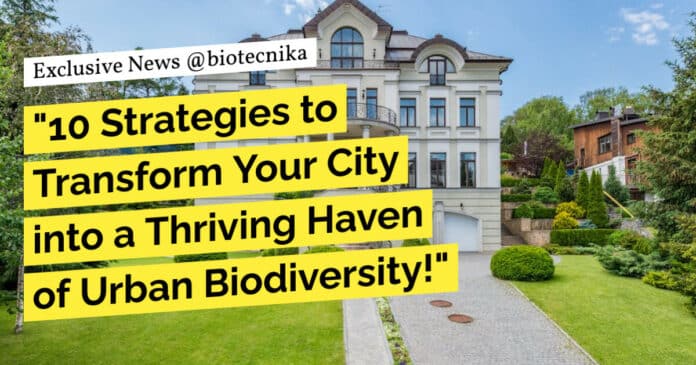Enriching Urban Biodiversity for Sustainable Cities
In recent years, the concept of sustainable cities has gained significant attention as urbanization continues to increase. As we strive to create environmentally friendly and resilient cities, it is crucial to address the issue of urban biodiversity. However, this aspect often goes overlooked when discussing sustainability. In this article, we will explore the importance of urban biodiversity and its role in creating sustainable cities.
What is Urban Biodiversity?
Urban biodiversity refers to the variety of plant and animal species found in urban areas. It includes everything from trees and flowers to insects and birds. While cities are typically associated with concrete, buildings, and pollution, it is possible to create space for nature within urban environments. Urban biodiversity plays a crucial role in maintaining ecological balance, providing ecosystem services, and enhancing the overall well-being of residents.
The Benefits of Urban Biodiversity
1. Ecological Balance: Urban biodiversity helps maintain a healthy balance between different species, promoting ecological resilience. Different plants and animals have interdependent relationships, such as pollinators relying on flowers for nectar. By providing suitable habitats for these species, urban biodiversity ensures the continuation of these vital connections.
2. Ecosystem Services: Urban green spaces, such
as parks and gardens, contribute to various ecosystem services. Trees, for example, improve air quality by absorbing pollutants and releasing oxygen. They also provide shade, reducing the overall temperature of cities and mitigating the urban heat island effect. Moreover, urban green spaces act as natural stormwater management systems, reducing the risk of flooding.3. Human Well-being: Access to nature has been proven to have numerous benefits for human well-being. Urban biodiversity offers opportunities for residents to connect with nature, improving mental health and reducing stress. Green spaces provide recreational areas for physical activities, promoting a healthier lifestyle. Additionally, studies have shown that exposure to nature increases productivity and creativity.
4. Climate Change Adaptation: Urban biodiversity plays a crucial role in climate change adaptation. Trees and vegetation act as natural carbon sinks, absorbing and storing carbon dioxide, a greenhouse gas responsible for climate change. By increasing the green cover in cities, we can mitigate the impacts of climate change and create more resilient urban areas.
How to Enrich Urban Biodiversity
1. Green Infrastructure: Incorporating green infrastructure into urban planning is essential for enriching urban biodiversity. This includes creating green belts, urban parks, rooftop gardens, and vertical greenery systems. These spaces provide habitats for various species, increase green cover, and improve overall air quality.
2. Native Planting: Choosing native plant species for landscaping and gardening is vital for supporting urban biodiversity. Native plants have adapted to the local environment, requiring less water, and providing food and shelter for native wildlife. Avoiding invasive species is equally important, as they can outcompete and displace native plants, disrupting the ecosystem.
3. Encouraging Citizen Engagement: Engaging citizens in biodiversity conservation is key to creating sustainable cities. Encourage community participation in tree planting initiatives, garden maintenance, and conservation projects. Providing educational programs and promoting citizen science can also enhance public awareness and understanding of urban biodiversity.
4. Wildlife-Friendly Design: Designing urban spaces with wildlife in mind helps create suitable habitats for various species. Incorporate features like birdhouses, insect hotels, and butterfly gardens. Preserving existing natural habitats, such as wetlands and forests, within cities is also essential for supporting biodiversity.
In our pursuit of sustainable cities, we must not overlook the importance of urban biodiversity. By incorporating green infrastructure, promoting native planting, engaging citizens, and designing wildlife-friendly spaces, we can enrich urban biodiversity and create more sustainable and resilient cities. By doing so, we can ensure a healthier environment for ourselves and future generations.
Keywords: urban biodiversity, sustainable cities, ecological balance, ecosystem services, human well-being, climate change adaptation, green infrastructure, native planting, citizen engagement, wildlife-friendly design.



























